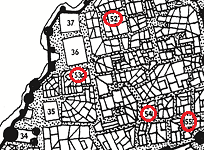In my previous Tékumel Thursday, I talked about understanding the map of the city of Jakálla, and one of the questions I did not answer was “where are the marketplaces of the city?” That is a very good question, and one that needs direct attention. But I want to start with two observations to act as a frame for my answer.
The first observation is that Empire of the Petal Throne was largely written in 1974, immediately after OD&D came out. In OD&D there is only passing mention of how and where to buy anything:
“…a map of the town or village closest to the dungeons (where adventurers will be most likely to base themselves)…. “‘Blackmoor’ is a village of small size (a one-horse town), while ‘Greyhawk’” is a large city. Both have maps with streets and buildings indicated, and players can have town adventures roaming around the bazaars, inns, taverns, shops, temples,and so on. Venture into the Thieves’ Quarter only at your own risk!” (OD&D Book III)
So there was a clear suggestion of places of commerce and interest, which in turn affected the presentation of the map of the city of Jakálla. The second observation is that modern 21st Century gamers are far too likely to look at that map and view it as a “photographic” view of the city – which is probably too literal an interpretation.
Prof. Barker was not a geographer, urban or otherwise. He described his approach to worldbuilding as closing his eyes and “seeing” Tékumel, an intensely personal creative process. What this means is that the map of the city of Jakálla contains all sorts of things not directly labeled on the original map, but which we can infer from what is mentioned and what we know. Put another way, we need to avoid the mistake of interpreting the absence of evidence as evidence of absence.
So, what is marked on the map which might indicate places of commerce? Not too surprisingly, for a game involving combat and defeating monsters, the placement and location of armories was of paramount importance. In the Foreigners Quarter, there are five distinct armories (all reference numbers are taken from the key to the Jakálla city map):
52. Armoury of Bushétra the Smith.
53. Armoury of the Silver Gauntlet.
54. Armoury of Vrí of Púrdimal.
55. Armoury of the Omniscient Eye of the Emperor.
56. Armoury of the Shield of Imperial Valour.

The armories of Bushétra the Smith (#52) and the Silver Gauntlet (#53) are close to the most expensive hostels, which might indicate that they were intended for a better-off clientele. The armories of Vrí of Púrdimal (#54) and the Omniscient Eye of the Emperor (#55) are both relatively close to the Palace of Ever-Glorious War and the Temple of Karakán. The Armoury of Vrí of Púrdimal might have a connection to the Legion of Héketh of Púrdimal, but since their barracks are across the city, this is unclear.
The last armory, the Armory of the Shield of Imperial Valour (#56), is located pretty much equidistant from three hostels, all for lower classes than the ones further north. These are the House of the Green Kirtle, Resthouse for Foreigners and Visitors of Middle Status (#32), the Hostel of Birrukú the Allaqiyáni, Resthouse for Foreigners and Visitors of Lower-Middle Status (#33), and the Tower of the Red Dome, Resthouse for Poor and Indigent Foreigners and Visitors of No Status (#34). This could indicate that the Armory of the Shield of Imperial Valour would be the first place recently-arrived foreign persons might go to obtain weapons and armor. (see below)

Before concluding, one might ask “so why armories? Why not something else?” Again, I think it is important to remember that Empire of the Petal Throne came along immediately after OD&D, and the focus of the game was all about fighting and combat. Adventurers recently arrived in Tsolyánu would need weapons and armor to go questing in Underworlds. But there would also be other businesses and merchants of interest, once the players gathered their loot and decided to go shopping.
So what does this mean? Since the Foreigners Quarter contains a wide variety of people of different classes and nationalities, I would suggest there are marketplaces with many other merchants and businesses where these armories are established. Given the size of Jakálla – a city of nearly a million people – these marketplaces will serve the immediate surrounding areas. In the Foreigners Quarter, one should be able to find basic necessities as well as exotic items from faraway places.
Next time, I will look at the armories and markets in the rest of Jakálla, with some thought about where the majority of commerce might take place.

Valid point about D+D, though given the long time Prof. Barker spent preparing it, it does seem a little odd that he gave marketplaces no thought.
Instead, perhaps there are no “marketplaces”, as such; you just go directly to the supplier, which would be a relationship mediated via clan or temple.
No, he *did* think about marketplaces – I really do think this was an example of how Empire of the Petal Throne had a number of omissions due to it being the second (or third) published TTRPG. I mean, it is possible to find out about clans from Empire of the Petal Throne, but we don’t have a list of them. There are suggestions and hints, but a fuller explanation of clans doesn’t take place until The Tekumel Sourcebook. Keep in mind that there aren’t any merchants at all in OD&D, so a lack of merchants past “the important ones” i.e. armorers, is an artifact of when the game was written. So we don’t need an alternative explanation, we just need to provide some idea of what’s where in Jakalla – it’s a BIG city, so that variety WILL be there.